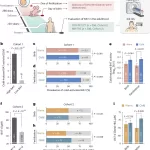August 14, 2024
In a groundbreaking study from the Keck School of Medicine of USC, researchers have discovered that young adults who vape exhibit DNA changes akin to those found in smokers—changes that are linked to an increased risk of developing cancer. Published in the American Journal of Respiratory Cell and Molecular Biology, this research represents the most comprehensive analysis of its kind to date.
The study, led by Dr. Stella Tommasi, Ph.D., an associate professor of research population and public health sciences at USC, utilized advanced genetic sequencing techniques to compare DNA methylation patterns across the genomes of young adults who vape, smoke, or abstain from nicotine products. DNA methylation, a process that can turn genes “on” or “off,” is crucial for normal cellular function. However, disruptions in this process are known to contribute to cancer and other diseases.
By analyzing nearly the entire genome of participants—unlike previous studies that examined only a small fraction—researchers identified significant similarities in DNA methylation between vapers and smokers. This overlap suggests that vaping may not be as safe as often claimed.
“Our findings reveal that the epigenetic changes in vapers could potentially contribute to the development of diseases such as cancer,” said Dr. Tommasi. “Despite electronic cigarettes containing lower levels of toxicants compared to traditional cigarettes, they are not without risk.”
The study involved 30 young adults, aged 23.5 on average, divided into three groups: vapers, smokers, and non-users. The researchers matched these groups by age, race, and gender, and accounted for other variables such as alcohol consumption and diet.
Using whole genome bisulfite sequencing, the team analyzed over 25 million DNA sites. They identified 831 differentially methylated regions (DMRs) in vapers and 2,863 in smokers. Notably, 346 of these DMRs were common to both groups and were associated with genes known to influence disease pathways.
A critical finding was the alteration of the HIC1 gene, a known tumor-suppressor gene, which was significantly methylated in both vapers and smokers. HIC1’s involvement in early cancer development and its presence in high-risk smokers’ blood samples underscores its potential as a predictive biomarker for early cancer detection.
Interestingly, over half of the DMRs found in vapers were unique to them, highlighting the distinct chemical exposures from vaping that may have their own health impacts.
The research team is now expanding their study to include a larger group of participants to further investigate the effects of e-cigarette flavors and additives on DNA methylation. Their aim is to develop a molecular signature to better assess the risks of vaping in the general population.
“This study opens up many avenues for further research,” Dr. Tommasi remarked. “It highlights the need to explore a wide range of candidate genes to assess the risks associated with vaping.”
As vaping continues to gain popularity, these findings emphasize the importance of understanding its long-term health effects and the potential need for regulatory measures to protect public health.
For more information, refer to the study published in the American Journal of Respiratory Cell and Molecular Biology by Stella Tommasi et al, titled “Epigenomic Dysregulation in Youth Vapers: Implications for Disease Risk Assessment.” DOI: 10.1165/rcmb.2024-0207OC.












